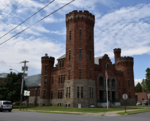Acker and Evans Law Office
1830 establishments in New York (state)Bank buildings on the National Register of Historic Places in New York (state)Buildings and structures in St. Lawrence County, New YorkCommercial buildings completed in 1830Greek Revival architecture in New York (state) ... and 6 more
Law officesLegal history of New York (state)National Register of Historic Places in St. Lawrence County, New YorkNew York State Register of Historic Places in St. Lawrence CountyOffice buildings on the National Register of Historic Places in New York (state)St. Lawrence County, New York Registered Historic Place stubs

Acker and Evans Law Office (also known as Ogdensburg Bank) is a historic office building in Ogdensburg, New York, United States. It is a rectangular Greek Revival style structure with a facade of smooth-faced, locally quarried white marble. It was built about 1830 as a bank, then used as a ticket agency, insurance office, express office, and finally as a law office.It was listed on the National Register of Historic Places in 1983.
Excerpt from the Wikipedia article Acker and Evans Law Office (License: CC BY-SA 3.0, Authors, Images).Acker and Evans Law Office
State Street, City of Ogdensburg
Geographical coordinates (GPS) Address Nearby Places Show on map
Geographical coordinates (GPS)
| Latitude | Longitude |
|---|---|
| N 44.697083333333 ° | E -75.4925 ° |
Address
State Street 315
13669 City of Ogdensburg
New York, United States
Open on Google Maps






